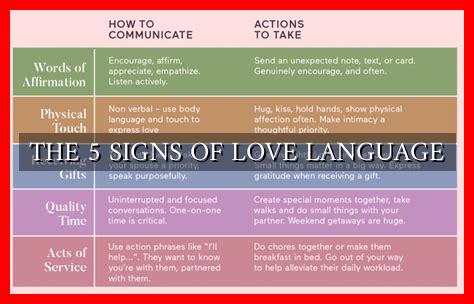-
Table of Contents
The 5 Signs of Love Language
Love languages are a concept introduced by Dr. Gary Chapman in his book “The 5 Love Languages.” According to Chapman, understanding your partner’s love language is crucial for a successful relationship. Each person has a primary love language that dictates how they express and receive love. By recognizing and speaking your partner’s love language, you can strengthen your bond and deepen your connection. Here are the 5 signs of love language to look out for:
1. Words of Affirmation
People whose love language is words of affirmation thrive on verbal expressions of love and appreciation. They value compliments, encouragement, and kind words. If your partner’s love language is words of affirmation, they may:
- Seek validation and reassurance through verbal affirmations
- Express their love through compliments and praise
- Feel hurt by criticism or harsh words
For example, if your partner’s love language is words of affirmation, they may feel most loved when you tell them how much you appreciate them or how proud you are of them.
2. Acts of Service
Individuals whose love language is acts of service feel loved when their partner goes out of their way to help them or do things for them. They value actions over words. If your partner’s love language is acts of service, they may:
- Feel most loved when you do things for them without being asked
- Appreciate gestures like cooking a meal, running errands, or helping with chores
- Feel neglected if you don’t follow through on promises or commitments
For example, if your partner’s love language is acts of service, they may feel most loved when you surprise them by taking care of a task they’ve been dreading.
3. Receiving Gifts
Some people feel most loved when they receive gifts from their partner. It’s not about the monetary value of the gift but the thought and effort behind it. If your partner’s love language is receiving gifts, they may:
- Value thoughtful gestures and surprises
- Feel loved when you remember special occasions with a gift
- Use gifts as a way to express their love and affection
For example, if your partner’s love language is receiving gifts, they may feel most loved when you give them a small token of appreciation, like a handwritten note or their favorite snack.
4. Quality Time
Individuals whose love language is quality time prioritize spending meaningful time together with their partner. They value undivided attention and shared experiences. If your partner’s love language is quality time, they may:
- Feel most loved when you make time for them and prioritize your relationship
- Enjoy activities like going for walks, having deep conversations, or watching movies together
- Feel neglected if you’re always distracted or too busy to spend time with them
For example, if your partner’s love language is quality time, they may feel most loved when you set aside dedicated time to connect with them, such as having a weekly date night or going on a weekend getaway.
5. Physical Touch
People whose love language is physical touch feel most loved through physical expressions of affection. They value hugs, kisses, cuddling, and other forms of touch. If your partner’s love language is physical touch, they may:
- Seek physical closeness and intimacy to feel connected
- Use touch as a way to express love and care
- Feel unloved or distant if physical touch is lacking in the relationship
For example, if your partner’s love language is physical touch, they may feel most loved when you hold their hand, give them a hug, or cuddle with them on the couch.
Conclusion
Understanding and speaking your partner’s love language is essential for building a strong and lasting relationship. By recognizing the signs of love language and making an effort to communicate love in a way that resonates with your partner, you can create a deeper connection and foster a more fulfilling partnership. Take the time to learn your partner’s love language and show them love in a way that speaks to their heart.
For more information on love languages and how to apply them in your relationship, check out Dr. Gary Chapman’s book “The 5 Love Languages” here.





